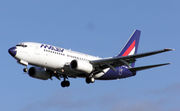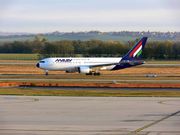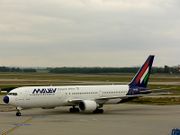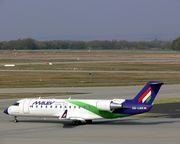Malév Hungarian Airlines
- Malev redirects here. For the military unit, see Malev (military unit)
 |
||||
|
||||
| Founded | 1946 (as Hungarian-Soviet Civil Air Transport Joint Stock Company) | |||
|---|---|---|---|---|
| Hubs | Budapest Ferihegy International Airport | |||
| Frequent-flyer program | Duna Club | |||
| Alliance | Oneworld | |||
| Fleet size | 22[1] (+19 orders) | |||
| Destinations | 50 | |||
| Company slogan | Wings to fly | |||
| Parent company | MNV | |||
| Headquarters | Budapest, Hungary | |||
| Key people | Martin Gauss (CEO) | |||
| Website | www.malev.com | |||
Malév Hungarian Airlines (Hungarian: Magyar Légiközlekedési Vállalat, abbreviated Malév) is the flag carrier and principal airline of Hungary. It has its head office in the Lurdy House in Budapest, with its main operations at Budapest Ferihegy International Airport. From there, the airline flies to 50 cities in 34 countries worldwide using a fleet of 22 airplanes. Malév is a member of the Oneworld alliance, joining 29 March 2007.[2] Malév - the accent indicates that the E is long, and the first syllable is always stressed in Hungarian, so the name is pronounced MAH-lev. The company's logo was designed by László Zsótér in 1989.
Contents |
History

Beginnings
Companies like Aero Rt. (founded 1910), Magyar Æeroforgalmi Rt. (MAEFORT) and Magyar Légiforgalmi Rt. (Malert) were spiritual forebears, but the devastation of World War II temporarily suspended all Hungarian civil aviation and these companies with it. The company's official founding date was 29 March 29, 1946, when the Hungarian-Soviet Civil Air Transport Joint Stock Company (Magyar-Szovjet Légiforgalmi Rt. also known as Maszovlet) was formed. The initial fleet consisted of 21-seat Li-2 passenger aircraft (the Soviet-licensed DC-3) and 3-seat Po-2 "taxis", used for precision air mail: sacks of mail were dropped from the aircraft when flying over its destination. In 1950, Malév's operating base moved from Budaörs to the newly opened airport at Ferihegy, where it has remained.
On 25 November 1956, Hungary acquired all the Soviet shares of Maszovlet, and Malev was born. Operations expanded, with flights extending to nearby countries and, following the 1968 purchase of jet-powered Tupolev Tu-134s from the Soviet Union, across Europe and the Middle East. Even before the political changes of 1989 and the arrival of democracy, Malev had begun phasing out its Soviet-era planes with the introduction of the first western aircraft, a Boeing 737-200 on 18 November 1988.
1990s-2007: Modernisation
The last Soviet-built Tupolev Tu-154 aircraft was withdrawn from service in 2001. In 2003, Malév began replacing its Boeing 737 Classic aircraft with 737 Next-Generation planes. It now runs a fleet of 18 Boeing 737 Next Generations, as well as 4 Bombardier Dash 8 Q-400s for short-haul routes.[3]
From 1999 to 2007, the Hungarian state property agency ÁPV Rt. (Állami Privatizációs és Vagyonkezelő Rt.) owned 99.5% of Malév shares. The other 0.5% are in the hands of small shareholders. ÁPV Rt has repeatedly tried to privatise Malév - finally selling it to AirBridge Zrt, one of whose stockholders is Boris Abramovich who backs KrasAir and AiRUnion.
2007-present: In private hands
AirBridge acquired 99.9% of the airline in February 2007. It had 1785 staff members, as of 31 December 2007.[4]
Despite Czech Airlines' offer to sponsor Malév as an associate member of the SkyTeam alliance, and Malév's codeshare agreements with several SkyTeam carriers, the airline choose to join Oneworld as a full member. Malév became a fully-fledged member of Oneworld on March 29, 2007.
On 12 July 2007 Lloyd Paxton was appointed CEO of Malev. Paxton replaced János Gönci, who will remain on the board of directors as an adviser. Mr Paxton was with British Airways for over 35 years and most recently was with Air Astana. Mr Paxton was the first Malev CEO to come from the airline industry. Two months later, on 14 September 2007, Lloyd Paxton resigned as CEO of Malév, replaced by Péter Leonov.[5] From January 2009, the present chairman is Ballo Anatoly Borisovich.[6]
On 18 March 2009 the Russian state-owned Vneshekonombank took a minority stake of 49% in AirBridge Zrt which holds the shares of the struggling airline. The bank owed it Ft8,100 (Ft8,100 (€30))m from a loan taken out last autumn. The majority, 51%, remained in Hungarian ownership. The managing control would be taken by Russia's Aeroflot - Russian Airlines.[7][8] Martin Gauss, former CEO of dba and Cirrus Airlines as well as a Boeing 737 pilot was elected as CEO on 15 April 2009.[9]
The airline was renationalized in February 2010, with Hungarian Government state holding company MNV acquiring a 95% stake in the airline. The remaining 5% remains with AirBridge.[10]
Company affairs and idenity
Head office

Malév's head office is located inside the Lurdy House (Lurdy Ház) in Budapest.[11][12] Lurdy Ház, an office and shopping complex, opened in the northern hemisphere autumn of 1998.[13] Previously the airline head office was located in another area in Budapest.[14][15]
Destinations

Malév Hungarian Airlines has en extensive flight network with 50 destinations covering most of Europe and the Middle East. In the past, flights were conducted to Africa and Southeast Asia, but have now been terminated. Apart from scheduled services, the airline also flies to charter destinations.
On 29 October 29, 2007, Malév announced the suspension of its trans-Atlantic routes for the winter season. Services on the Budapest-Toronto and Budapest-New York-JFK routes were suspended in mid-November. Passenger loads on these routes are considerably lower in winter, making them uneconomical to operate.[16] Malév wet-leased its Boeing 767-200ER to Oman Air until late March 2008; this helped Malév earn revenue.
In May 2008 the airline terminated services to the Egyptian capital, Cairo, its only scheduled service Africa. The service was operated four times a week with Boeing 737-600s and Boeing 737-700s. The airline continues to serve Egypt (Sharm el-Sheikh and Hurghada) on a charter basis.
On 23 July 2008, Malév announced the cancellation of its long-haul flights. Malév has operated flights to Toronto and New York since the early 1990s but the recent increases in operational costs, especially fuel costs have made the flights unprofitable. Malév has no plans to reinstate its trans-Atlantic flights but will instead focus on expanding its European network.[6]
Malév Hungarian Airlines has codeshare agreements with the following airlines:
|
|
|
Fleet
Current
The Malév Hungarian Airlines fleet consists the following aircraft with an average age of 7.16 years (at 21 February 2010):[17][18]
| Aircraft | In Fleet | Orders | Options | Passengers | Notes | ||
|---|---|---|---|---|---|---|---|
| C | Y | Total | |||||
| Boeing 737-600 | 6 | 0 | 0 | 16 | 93 | 109 | |
| Boeing 737-700 | 7 | 0 | 0 | 16 | 105 | 121 | |
| Boeing 737-800 | 5 | 0 | 0 | 11 | 153 | 164 | 1 operating for Livingston Energy Flight |
| Bombardier Dash 8 Q400 | 4 | 4 | 4 | 0 | 72 | 72 | Deliveries: 2012 |
| Sukhoi Superjet 100 | 0 | 15 | 15 | 0 | 95 | 95 | Entry into service: 2011-2016 |
| Total | 22 | 19 | 19 | Last updated: 21 February 2010 | |||
Services are operated for the airline by Budapest Aircraft Service, primarily using 30-seat Embraer EMB 120 Brasilia to regional destinations.
Malév leased the first of three Boeing 767-300ERs in early 2007, with the intention of adding one aircraft per year, and the last joining the fleet in 2009. These aircraft would have replaced the two Boeing 767-200ERs in Malév's fleet.
At the Farnborough Air Show in July 2008, Malév signed a contract with Canada's Bombardier for the delivery of eight Q400 turboprop aircraft with an option for a further four at a cost of Ft61,330 (Ft61,330 (€226))m to replace the regional CRJ and Fokker 70 fleet.[19]
Malév returned its leased Boeing 767-300ER (HA-LHC) to ILFC by October 2008. Airline S7 of Russia will then lease this former KLM B767 for a 6-year period. The fate of Malév's other B767, a –200ER is unknown but it will most likely be sold.[20]
On 15 June 2009, SuperJet International and Malév Hungarian Airlines signed a Letter of Intent for the purchase of 30 Sukhoi Superjet 100-95 aircraft. The first aircraft, in a two-class configuration, will join the Malév fleet from 2011 with the delivery of six aircraft per year.[21]
Retired


- Bombardier CRJ200
- Boeing 737-200
- Boeing 737-300 replaced by Boeing 737-700
- Boeing 737-400 replaced by Boeing 737-800
- Boeing 737-500 replaced by Boeing 737-600
- Boeing 767-200ER
- Boeing 767-300ER
- Fokker 70
- Ilyushin Il-14
- Ilyushin Il-18
- Ilyushin Il-62
- Lisunov Li-2
- Polikarpov Po-2
- Tupolev Tu-134
- Tupolev Tu-154
- Yakovlev Yak-40
Incidents and accidents
- On November 23, 1962, Malév Airlines Flight 355, an Ilyushin Il-18V (HA-MOD), crashed at Paris - Le Bourget Airport, probably as the result of a stall; all 21 on board died.[22]
- On August 28, 1971, a scheduled Malév Airlines flight, an Ilyushin Il-18V (HA-MOC) crashed into the sea on approach to Copenhagen Airport, killing 32; 2 survived.[23]
- On September 16, 1971, Malév Airlines Flight 110, a Tupolev Tu-134 (HA-LBD) crashed near Boryspil International Airport, Kiev in bad weather, following two missed approaches, after a generator failure caused the crew to switch to batteries; all 49 on board died.[24]
- On 30 September 1975 a Malév Tupolev Tu-154 aircraft on the Budapest to Beirut route crashed near the Lebanese shoreline. See Malév Flight 240.
- On September 21, 1977, a Malev Tupolev Tu-134 aircraft (HA-LBC), flying from Istanbul to Bucharest struck level ground on approach, probably as a result of flying at reduced power, unnoticed by the crew. Of the 53 on board, 23 died.[25]
- On March 29, 1989, two teenagers from Czechoslovakia armed with grenades and shotguns hijack Flight 640 at Prague Ruzyně Airport, and fly the Tupolev Tu-154B with 15 hostages to Frankfurt Airport before surrendering.[26]
- On 4 July 2000, Flight 262, a chartered MALÉV Tu-154 HA-LCR, landed on its belly in Salonica in Greece. The crew had forgotten to lower the undercarriage and the plane skidded 400 metres (440 yards) on the runway. The plane was able to become airborne again as the pilots applied full throttle. It circled while the crew lowered the undercarriage and landed safely. There were no injuries, but the aircraft was written off.
- On 13 February 2009, MALÉV Flight 440 a scheduled MALÉV flight Bombardier Dash 8 Q400 from Budapest to Skopje made an emergency landing at the Skopje Airport in Republic of Macedonia. At 16,05 CET the pilot reported right engine failure on the final approach to Skopje LWSK. The pilot safely landed the airplane and there were no injuries reported among the 64 passengers in the aircraft. General Manager of Skopje Airport confirmed the incident.[27][28][29]
References
- ↑ "Malév Ltd. Company Profile". Malév Hungarian Airlines. http://www.malev.com/companyinformation/introduction/malev-company-profile. Retrieved 1 July 10.
- ↑ "Directory: World Airlines". Flight International: pp. 46–47. 2007-04-10.
- ↑ "Malév history". Malev.com. http://www.malev.com/companyinformation/malev-history/short-history-malev-1946-2008. Retrieved 2010-02-13.
- ↑ "Annual Report 2007". Malév Ltd.. http://www.malev.com/Root/MalevDocuments/ceginformaciok/annual_reports/2007_ANNUAL_REPORT.pdf. Retrieved 2010-02-13.
- ↑ "Lloyd Paxton Leaves Malev After Two Months, Peter Leonov Is New CEO". Airliner world. 2007-07-14. http://airlineworld.wordpress.com/2007/09/14/lloyd-paxton-leaves-malev-after-two-months-peter-leonov-is-new-ceo/. Retrieved 31 July 2010.
- ↑ 6.0 6.1 Malév Hungarian Airlines (2008-08-27). "Focus on Europe". Press release. http://www.malev.com/CompanyInformation/PressReleases/Article?Content=/Root/MalevContents/En/company-information/pressreleases/press-releases/2009/2/new-chairman-at-head-of-malev. Retrieved 2010-02-13.
- ↑ http://origin2.foxnews.com/wires/2009Jan24/0,4670,EURussiaMalev,00.html
- ↑ "Russian bank takes over Malev". ABTN. 2009-01-27. http://www.abtn.co.uk/news/russian-bank-takes-over-malev. Retrieved 2010-02-13.
- ↑ Malev.com (2009-04-16). "Experienced Germaan airline manager". Press release. http://www.malev.com/companyInformation/pressreleases/article?Content=/Root/MalevContents/En/company-information/pressreleases/press-releases/2009/4/experienced-german-airline-manager. Retrieved 2010-02-13.
- ↑ Flightglobal: Troubled Malev is renationalised 27 Feb 10
- ↑ "Terms & Conditions." Malév Hungarian Airlines. Retrieved on 28 February 2010.
- ↑ "Communicating change." Europe Intelligence Wire. 12 January 2004. Retrieved on 28 February 2010. "Varadi spoke recently with reporter Anita Benko at Malev's head office in the Lurdy Haz shopping and..."
- ↑ "About Us." Lurdy Ház. Retrieved on 28 February 2010.
- ↑ "World Airline Directory." Flight International. 26 March-1 April 1997. 86.
- ↑ "Offices in Hungary." Malév Hungarian Airlines. 13 June 1998. Retrieved on 28 February 2010.
- ↑ Malév Hungarian Airlines. "New York and Toronto flights suspended for winter". Press release. http://www.malev.hu/BP/ENG/I_NEWS_ENG/2007-1029-1551-07PGDK.asp.
- ↑ "CH-Aviation: Malév Hungarian Airlines". CH-Aviation. http://www.ch-aviation.ch/aircraft.php?search=set&airline=MA&al_op=1.
- ↑ Horizon. Malév. 2009-9. http://www.malev.hu/Root/MalevDocuments/horizon/2009/horizon_junius_2009_webre.pdf. Retrieved 2010-02-13.
- ↑ "Malév to buy new aircraft". Caboodle.hu. 2008-07-16. http://www.caboodle.hu/nc/news/news_archive/single_page/article/11/malev_to_buy/?cHash=e3cb2c627c. Retrieved 31 July 2010.
- ↑ CH-Aviation - Airline News, Fleet Lists & More
- ↑ Kaminski-Morrow, David (15/06/09). "PARIS AIR SHOW: Superjet 100 takes off with Malév order". FlightGlobal. http://www.flightglobal.com/articles/2009/06/15/328081/paris-air-show-superjet-100-takes-off-with-malev-order.html/.
- ↑ "ASN Aircraft accident Ilyushin 18V HA-MOD Paris-Le Bourget". Aviation-safety.net. http://aviation-safety.net/database/record.php?id=19621123-0. Retrieved 2010-02-13.
- ↑ "ASN Aircraft accident Ilyushin 18V HA-MOC Saltholm Island". Aviation-safety.net. http://aviation-safety.net/database/record.php?id=19710828-0. Retrieved 2010-02-13.
- ↑ "ASN Aircraft accident Tupolev 134 HA-LBD KievKiev-Borispol Airport (KBP)". Aviation-safety.net. http://aviation-safety.net/database/record.php?id=19710916-2. Retrieved 2010-02-13.
- ↑ "ASN Aircraft accident Tupolev 134 HA-LBC Urziceni". Aviation-safety.net. http://aviation-safety.net/database/record.php?id=19770921-1. Retrieved 2010-02-13.
- ↑ "2 Czech Youths Hijack Jetliner to West Germany". Los Angeles Times. March 30, 1989. http://articles.latimes.com/1989-03-30/news/mn-878_1_west-germany. Retrieved August 19, 2010.
- ↑ posten (2009-02-14). "AUA-Maschine musste nach Start in Skopje umkehren - Flugzeugunglücke - derStandard.at › Panorama". Derstandard.at. http://derstandard.at/?url=/?id=1234507062719. Retrieved 2010-02-13.
- ↑ "Dva prinudna sletanja u Skoplju" (in Serbian). B92. 2009-02-13. http://www.b92.net/info/vesti/index.php?yyyy=2009&mm=02&dd=13&nav_category=167&nav_id=344891. Retrieved 2010-02-13.
- ↑ "Избегнати инциденти на скопскиот аеродром" (in Macedonian). A1.com.mk. 2009-02-13. http://www.a1.com.mk/vesti/default.aspx?VestID=104381. Retrieved 2010-02-13.
External links
|
||||||||||||||||||||||||||||||||||||||||||||||||||||||||||||||||||||||||||||||||||||||||||||
